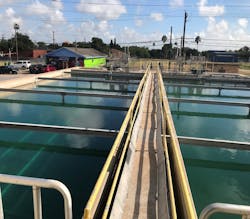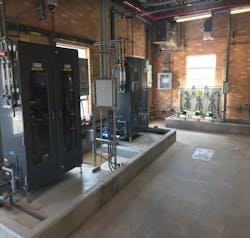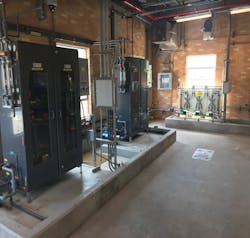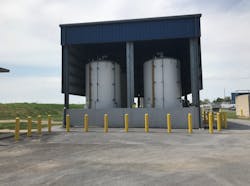About the author:
Cristina Tuser is associate editor for WWD. Tuser can be reached at [email protected]
From 2000 to 2014, the Weslaco Water Treatment Plant in Texas was under capacity and in need of a rehab. The plant opted to rehab and build a new 8 million gallon per day (mgd) facility.
The plant currently serves approximately 40,000 residents and after repairs, maintains 18 mgd. When Inframark took over in October 2015, its goal was to make necessary major improvements while meeting compliance standards.
In total, the plant has a staff of six people. According to Weslaco Chief Operator Jorge Pena, raw water comes from the Rio Grande then to the irrigation district canal and lastly, to the plant’s reservoir. From the reservoir, the water gets pumped to the rapid mixers. Half way from the raw water pump station, to the mixers, the first chemical injected is chlorine dioxide, which is used as a disinfectant and for taste and order.
Before the upgrades, Pena had a vendor stop by the plant, explaining how his product would reduce costs. In the past, the plant used a three chemical system generator, which consisted of chlorite, hydrochloric acid and sodium hypochlorite to produce chlorine dioxide for disinfection. After recognizing the cost savings of the new system, the plant made the switch to a two chemical system generator that uses Purate—a solution of sodium chlorate and hydrogen peroxide—and sulfuric acid to form chlorine dioxide.
After going through the rapid mixers, the water travels to the flocculators for additional mixing and then into the sedimentation basins or the clarifiers to settle the turbidity. Once the turbidity settles, it travels through the settle water channel into the filters for filtration, after which the water flows into the transfer station, where it gets pumped to the clear well and out to the water towers and distribution system.
When Inframark rehabilitated components at the WTPs, part of the work included several lift stations, which cost about $500,000. These repairs ultimately resulted in significant savings. Upgrades were also made to the plant’s clarifiers and aerators, and it upgraded to ultraviolet and polymer systems, all for less than $300,000. Finally, repairs were made to the sedimentation basin flight and chain at the water treatment plant for approximately $10,000.
According to Pena, the water treatment plant has not had any water violations since Inframark took over rehabilitation efforts. For the latest quarter assessed by the U.S. EPA, tap water provided by the water utility was in compliance with federal health-based drinking water standards.
A goal for plant operations was to first and foremost maintain quality water for residents while maintaining clear communication with the plant’s essential workers. Of the many challenges while the construction was going on, the most pressing were maintaining compliance with the old water plant operations; coordinating daily with the builders; testing new equipment; and ensuring chemical adjustments to get the new plant running were going to produce quality drinking water for residents.
Nevertheless, the Weslaco Water Treatment Plant has not had a water boil notice since 2014 and continues to run smoothly, despite COVID-19 precautions that have been implemented to ensure operations continue.
“Since we started operations in 2015, our staff at the Weslaco Water Treatment Plant has worked diligently to maintain excellent compliance and maintain upkeep of the facility’s appearance,” Pena said. “Most importantly, we have produced safe and clean drinking water, even during times of distress such as flooding and the pandemic. With the new Plant 5, we are able to continue meeting and exceeding water demand, which in the past could be challenging at times.”



